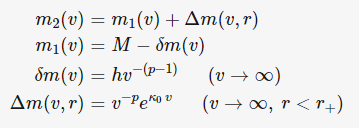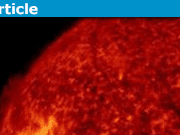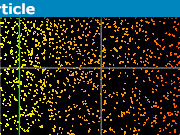What is Mass Inflation? A 5 Minute Introduction
Table of Contents
Definition/Summary
Abstract from Poisson and Israel’s 1990 paper, ‘Internal structure of black holes’-
‘The gravitational effects associated with the radiative tail produced by a gravitational collapse with rotation are investigated. It is shown that the infinite blueshift of the tail’s energy density occurring at the Cauchy horizon of the resulting black hole causes classically unbounded inflation of the effective internal gravitational-mass parameter of the hole. Since this effect is causally disconnected from any external observer, the black-hole external mass remains bounded. The mass inflation phenomenon causes the spacetime curvature to grow to Planckian scales on a spacelike hypersurface in the vicinity of the Cauchy horizon, beyond which the classical laws of general relativity break down. A consequence is that an observer’s trip to this hypersurface embraces all but the last Planck time of the entire black-hole classical history.’
from ‘Structure of the Inner Singularity of a Spherical Black Hole’ which was co-written with W. Israel 1994-
‘(Poisson’s) doctoral dissertation was on the concept of mass inflation, (not to be confused with cosmological inflation), which he pioneered with Israel in a series of seminal papers. Prior to the understanding of mass inflation, it was believed that wormholes into other universes would be found inside some black holes. Mass inflation closes off these wormholes in realistic black holes. Poisson’s work on black hole interiors has been reviewed in popular science books as well as in the scientific press.
Equations
‘..spacetime has a scalar curvature singularity at the Cauchy horizon induced by the divergence of the inner mass parameter [itex]m_2(v)[/itex].’

where [itex]\Delta m[/itex] is the mass-energy of the outgoing null shell [itex]S[/itex], M is the gravitational radius, [itex]\delta m[/itex] is the mass-energy of the radiation influx, h is a constant regarding the nature of the gravitational source, v represents ingoing null coordinates, p determines the decay rate of the ingoing radiation ([itex]\geq11[/itex] for gravitational radiation) and [itex]\kappa[/itex] is the Cauchy horizon Killing surface gravity.
[itex]\delta m[/itex] is associated with the inverse power law decrease of late-time fields (sometimes referred to as Price’s power law damping of radiative tails) which get backscattered into the black hole.
Cauchy horizon Killing surface gravity-
[tex]\kappa_0=\frac{r_+-r_-}{2(r_-^2+a^2)}[/tex]
where [itex]r_+[/itex] is the outer event horizon, [itex]r_-[/itex] is the inner (Cauchy) event horizon and [itex]a[/itex] is the spin parameter in metres (this appears to remain in geometric units).
which produces a final equation for [itex]m_2(v)[/itex]-
[tex]m_2(v)=M-hv^{-(p-1)}+v^{-p}e^{\kappa_0\,v}[/tex]
where the second part of the equation [itex](\Delta m)[/itex] is only applicable inside the EH [itex](r_+\rightarrow r_-)[/itex]. [itex]m_2(v)[/itex] remains equal to M until at the Cauchy horizon where it blows up in a Dirac delta type manner. Outside the event horizon [itex](r>r_+)[/itex], m stays bounded and resembles [itex]m_1(v)[/itex] at late times.
‘..Thus [itex](\Delta m)[/itex] diverges when v goes to infinity because the exponential growth is dominant compared to the inverse power attenuation of [itex]1/v^p[/itex]. In other words, when the shell [itex]S[/itex] approaches the Cauchy horizon [itex](v\rightarrow \infty)[/itex], its mass increases without bound..’
Basically [itex]m_2(v)[/itex] replaces M in the quadratic invariant curvature scalar for black holes.
Extended explanation
Null Coordinates
v is the ingoing null coordinate from E-F coordinates-
v=t+r*
where the outgoing null coordinate is expressed-
u=t-r*
where r* is the tortoise coordinate
The tortoise coordinate in some way relates the local behavior of light relative to the observer at infinity or as UFPA puts it, ‘..In some sense, the tortoise coordinate reflects the fact that geodesics take an infinite coordinate time to reach the horizon..’
while for Minkowski spacetime v=t+r≡2r, for curved spacetime v=t+r*≠2r. v and u must satisfy r*=(v-u)/2 and t=(v+u)/2.
In respect of rotating black holes, the change in the tortoise coordinate is-
[tex]dr^\star=\frac{r^2+a^2}{\Delta}\,dr[/tex]
where [itex]\Delta=r^2-2Mr+a^2[/itex] which is equivalent to [itex](r-r_+)(r-r_-)[/itex] where [itex]r_\pm=M \pm \sqrt(M^2-a^2)[/itex]
tortoise coordinate for Kerr black hole-
[tex]r^\star(r)=r+\frac{2Mr_+}{r_+-r_-} \ln\left|\frac{r-r_+}{2M}\right|-\frac{2Mr_-}{r_+-r_-} \ln\left|\frac{r-r_-}{2M}\right|[/tex]
which reduces to the static solution when a/M=0.
v=t+r* provides v=∞ at large radii, v=-∞ at r_+, v=∞ at r_- and finite at r=0; the opposite applies for u=t-r* (i.e. u=-∞ at large radii, u=∞ at r_+, etc.).
(for a charged and rotating blak hole (Kerr-Newman solution), presumably the above transformation would still apply but with [itex]\Delta=r^2-2Mr+a^2+Q^2[/itex] and [itex]r_\pm=M \pm \sqrt(M^2-a^2-Q^2)[/itex], [itex]r_\pm[/itex] relative to charge would also apply when calculating the Killing surface at the Cauchy horizon).
Potential Barrier
As v moves from ∞ to -∞ and back again, there are points where v=0 which causes m_1(v) and m_2(v) to blow up and become unbound at specific radii. This may have been discussed in this paper where it’s possibly referred to as the external and internal potential barrier.
In this paper (page 14), though the equations are different, they seem to refer to something similar in the shallow region of a black hole and even state it’s related to u→0.
This link refers to v=0 as r_0, the peak of the potential barrier, ‘..wave scattering on the peak of the potential barrier..’-
also ‘..perturbations are scattered by the black hole’s external potential barrier so that part of the radiation falls into the black hole..’-
http://arxiv.org/abs/gr-qc/9411050 page 2
A similar description applying to v=0 inside the event horizon, ‘..The radiation which crosses the event horizon gets scattered once again by the inner gravitational potential barrier..’-
http://arxiv.org/abs/gr-qc/9805008 page 6 fig. 2
Invariant Curvature Scalar
m_2(v) can replace M in the Kretschmann scalar to provide the quadratic scalar invariant for a rotating black hole incorporating mass inflation at the Cauchy horizon.
The Kretschmann invariant for a Kerr black hole incorporating mass-inflation-
[tex]K=R_{abcd}R^{abcd}=\frac{48m_2^{\ 2}(v_2)(r^2-a^2cos^2\theta)[(r^2+a^2cos^2\theta)^2-16r^2a^2cos^2\theta]}{(r^2+a^2cos^2\theta)^6}[/tex]
where m_2(v) replaces M, a=J/mc and θ is the angle between the z axis (i.e. pole) and the line of approach.
There are now two singularities, one at r_- and the other at r=0; θ=π/2.
Invariant curvature scalar for a charged and rotating black hole- link
Sources
‘The Universality of Mass Inflation Inside Black Holes’ by J. S. F. Chan
http://uwspace.uwaterloo.ca/handle/10012/225
‘Structure of the Inner Singularity of a Spherical Black Hole’ by A. Bonanno, S. Droz, W. Israel and S.M. Morsink
http://arxiv.org/abs/gr-qc/9403019
‘Mass Inflation in a Rotating Charged Black Hole’ by A. Bonanno
http://arxiv.org/abs/gr-qc/9507047
This article was authored by several Physics Forums members with PhDs in physics or mathematics.










Leave a Reply
Want to join the discussion?Feel free to contribute!